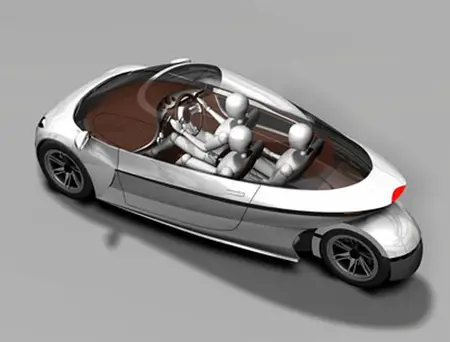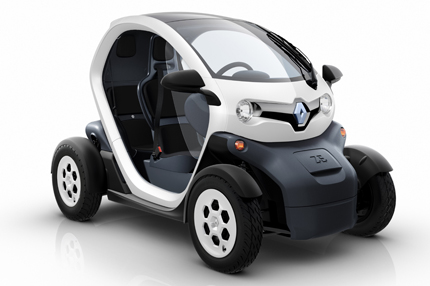Some
of the world's best inventions and new products are based on plain
common sense of the type "why didn't I come up with that?". Facebook of
course is one of them. It is a powerful medium for bringing people
closer together. If you think of it, that used to be the car's domain...
 What if the car would show more resemblance to what the new media are offering? More cost- and time-efficient, less cumbersome, less of a
burden to the environment, less self-serving, using less precious
resources to begin with, and offering unique new selling points?
What if the car would show more resemblance to what the new media are offering? More cost- and time-efficient, less cumbersome, less of a
burden to the environment, less self-serving, using less precious
resources to begin with, and offering unique new selling points?
You would end up with a Best of Both Worlds, combining two of the biggest markets out there. The car still signifies the largest purchase one can make after buying a new home. New media of course are the hottest ticket today.
 What if the car would show more resemblance to what the new media are offering? More cost- and time-efficient, less cumbersome, less of a
burden to the environment, less self-serving, using less precious
resources to begin with, and offering unique new selling points?
What if the car would show more resemblance to what the new media are offering? More cost- and time-efficient, less cumbersome, less of a
burden to the environment, less self-serving, using less precious
resources to begin with, and offering unique new selling points?
You would end up with a Best of Both Worlds, combining two of the biggest markets out there. The car still signifies the largest purchase one can make after buying a new home. New media of course are the hottest ticket today.

So, a very interesting question is how to have the car use up less energy and how to have it 'eat away' less valuable resources all together? Preferably of course without compromising safety, comfort, the sheer pleasure of driving, and without making cars too costly to buy and operate. 90% of all cars carry just one person, particularly during rush hours when traffic is at its worst.
Rising energy costs and the recession force automakers to reassess their present
strategy. They still tend to think in terms of small cars. They shouldn't. Don't come up with yet another small car, come up with 'something in between'. Recently, it seems that Opel (Rak E), Peugeot (Velv), KTM (E3W), Renault (Twizy) and Toyota (i-Road) have taken it upon themselves to bridge the gap between automobiles and motorcycles - see pictures. Rightfully so. However, a job worth doing, is worth doing right.
 iPod, iPhone... iSetta
iPod, iPhone... iSetta
The Space-Efficient Vehicle is more comfortable, more practical and safer than the 'crossovers' depicted above. It offers a vision on personal mobility, as well as a choice. With its sleek and lightweight body, the SEV requires less material to produce, less fuel to propel and less space to do 99% of what the 'old car' was doing. This 'New Isetta' or 'Smart For Three' is sleek enough to let governments use the infrastructure more efficiently. The possibilities include opening up smaller -designated- lanes, allowing semi split-lane use, reconfigured parking lots and space-efficient interfaces with public transport. Think of the SEV as a new mobility mode, transportation format, must-have, gadget or toy - it may well cause the same stir Apple created (do the test) with its iPod and iPhone, followed by Samsung with their successful Galaxy series. Product design and new levels of functionality turned those companies into the most valued in the world!
Think different
A simple recipe: offer what others don't offer
Once in a while 'something' comes along that redefines the rules of the game and sets a whole new standard. Once again, California sets the pace (Apple is Ca-based). Jan. 2012 California's Advanced Clean Cars program became final. New rules require automakers to build cars and trucks that emit about three-quarters less smog producing pollutants. The program also calls for an increase in the number of hybrid and zero-emission vehicles on California's roads. The regulations would affect model years 2017 through 2025. What also may change the automotive landscape is that new generations don't seem to care too much for the automobile as we know it. GM recently decided to look for help from MTV. Now here's a chance too to make a difference as well... Mind you, any (eco-) car maker  that only focuses itself on propulsion technique is needlessly narrowing its chances of success. The trick of course is to get a feel for the bigger picture, broaden the basis and formulate an all-in-one answer to a lot of issues simultaneously. You will find investors and strategic partners far more likely to co-invest. Interesting is what Hertz Corp. President Michel Taride has to say about the future of automobilty. Google's driverless car research and Volkswagen's request to
Plug & Play Tech Centers to help them out with the search for and
the development of new connectivity technology proves that the car industry and the new media sector are rapidly closing in on
each other in the search for the next best thing.
that only focuses itself on propulsion technique is needlessly narrowing its chances of success. The trick of course is to get a feel for the bigger picture, broaden the basis and formulate an all-in-one answer to a lot of issues simultaneously. You will find investors and strategic partners far more likely to co-invest. Interesting is what Hertz Corp. President Michel Taride has to say about the future of automobilty. Google's driverless car research and Volkswagen's request to
Plug & Play Tech Centers to help them out with the search for and
the development of new connectivity technology proves that the car industry and the new media sector are rapidly closing in on
each other in the search for the next best thing.
 that only focuses itself on propulsion technique is needlessly narrowing its chances of success. The trick of course is to get a feel for the bigger picture, broaden the basis and formulate an all-in-one answer to a lot of issues simultaneously. You will find investors and strategic partners far more likely to co-invest. Interesting is what Hertz Corp. President Michel Taride has to say about the future of automobilty. Google's driverless car research and Volkswagen's request to
Plug & Play Tech Centers to help them out with the search for and
the development of new connectivity technology proves that the car industry and the new media sector are rapidly closing in on
each other in the search for the next best thing.
that only focuses itself on propulsion technique is needlessly narrowing its chances of success. The trick of course is to get a feel for the bigger picture, broaden the basis and formulate an all-in-one answer to a lot of issues simultaneously. You will find investors and strategic partners far more likely to co-invest. Interesting is what Hertz Corp. President Michel Taride has to say about the future of automobilty. Google's driverless car research and Volkswagen's request to
Plug & Play Tech Centers to help them out with the search for and
the development of new connectivity technology proves that the car industry and the new media sector are rapidly closing in on
each other in the search for the next best thing.
Easy to see why the SEV is safer (impact margins), more energy-efficient (streamline), more practical (three seats), and more comfortable (wheelbase) than the Smart ForTwo.
Jobs
When an industry yields massive savings for end-users (far less fuel needed), governments (better space utilization of the infrastructure) and the community (less CO2) as a whole, it not only brings an exciting new product to the market, new jobs are created, and the savings can also be spent somewhere else...
Sincerely,
Ralph Panhuyzen, Sept. 26th 2011 (updated Jan. 9th, 2013)
*Go to newisetta.com for more detailed information, to see pictures and to get a proper perspective. The SEV is OHIM (Office of Harmonization for the Internal Market) registered! It is not an open source project. Unauthorized use forbidden.
No use in coming up with something that other manufacturers are already offering. Therefore check: "What's out there?" - The SEV compared to other small eco-cars and EVs. ('right click' if not visible and click on 'reload tab' or open with Adobe Reader 7.0).
No use in coming up with something that other manufacturers are already offering. Therefore check: "What's out there?" - The SEV compared to other small eco-cars and EVs. ('right click' if not visible and click on 'reload tab' or open with Adobe Reader 7.0).
Why not have an Apple/Tesla-like approach, and take 'the product' to the prospective buyer, in shopping malls? Instead of relying on the customer to visit the dealer showroom. 'Personal mobility' is about a whole lot more than smart phones. May well boost brand interest overall...
PS: Ralph Panhuyzen was involved with the scientific study on car mobility in the Netherlands (one of the most densely populated countries in the world) which was held under the auspices of the NWO, the Netherlands Organization for Scientific Research. Link is gone, so I noticed. Here's the ISBN-13: 978-90-442-0015-7
PS: Ralph Panhuyzen was involved with the scientific study on car mobility in the Netherlands (one of the most densely populated countries in the world) which was held under the auspices of the NWO, the Netherlands Organization for Scientific Research. Link is gone, so I noticed. Here's the ISBN-13: 978-90-442-0015-7




